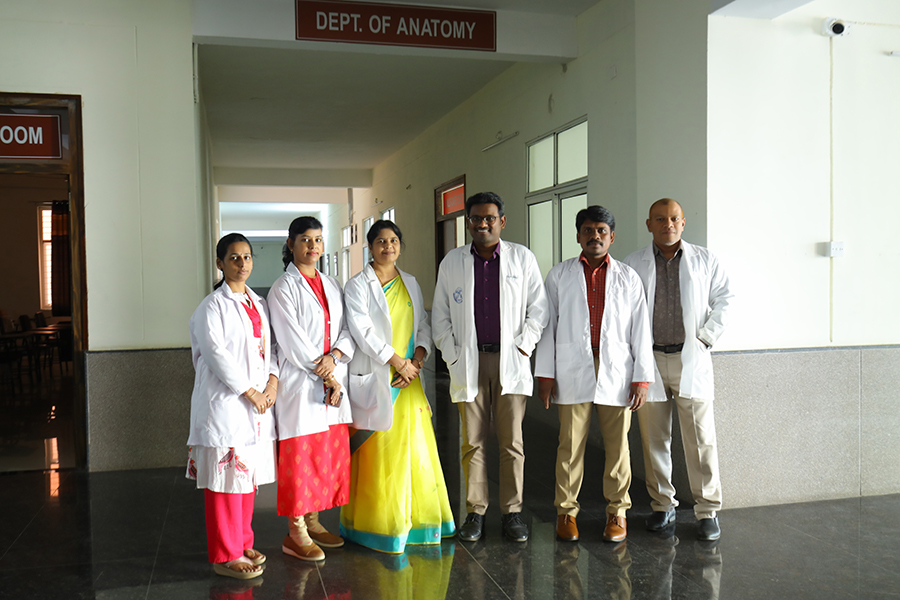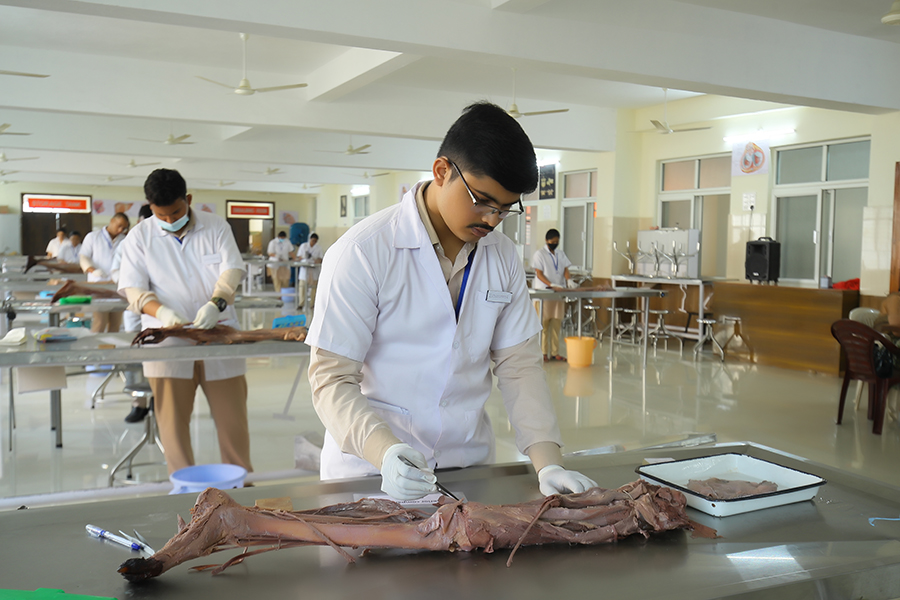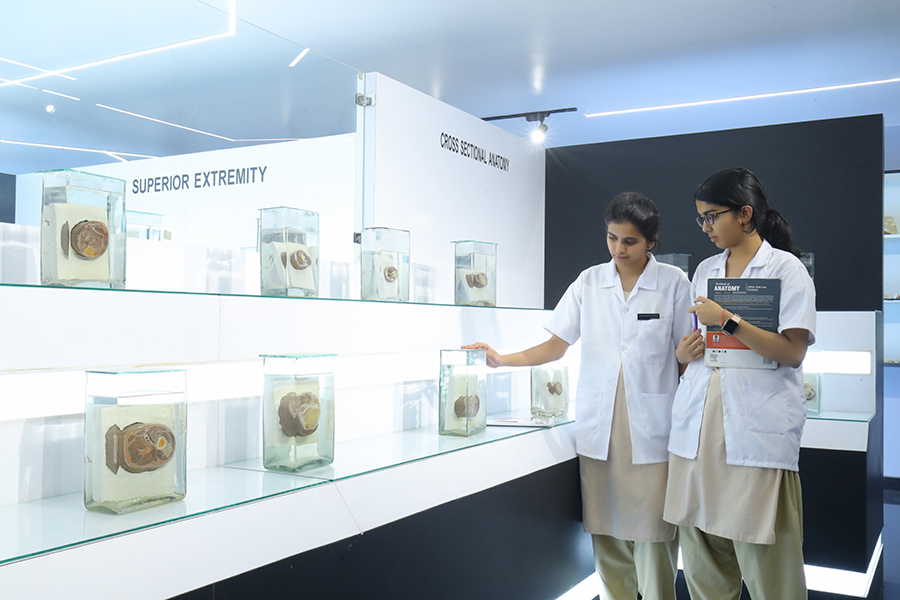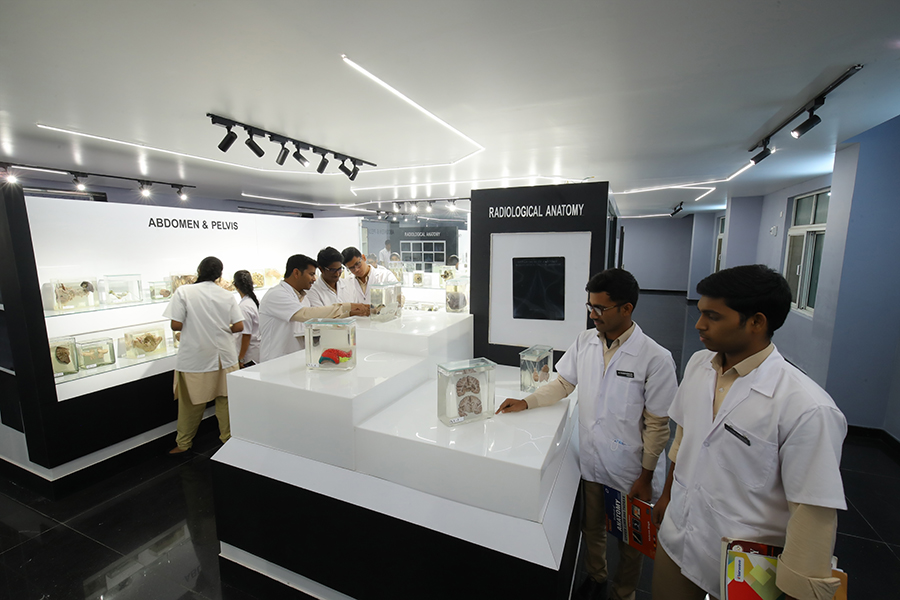Overview of Department: Anatomy Museum
Department of Anatomy was established in the year 1998, with a goal to contribute to the vision and mission of the Mamata medical college, in the areas of education, research and service and with an objective to train undergraduate and post graduate students in the fields of gross anatomy, osteology, microscopic anatomy, developmental anatomy, surface anatomy, neuroanatomy, radiological anatomy and also to conduct conferences, workshops and continuing medical education (CME) programs for an updated knowledge on recent advances in human anatomy, for the benefit of students and faculty as well.
The Faculty, Infrastructure and Equipment meet all the requirements of undergraduate and postgraduate teaching & learning and are in accordance with M.C.I and K.N.R.U.H.S Regulations.
Departmental Faculty:
| S.No. | Name | Designation |
| 1 | Dr. Udaya Kumar P | Professor & HOD |
| 2 | Dr. Thondapu Kalpana | Professor |
| 3 | Sujatha. N | Assistant Professor |
| 4 | Ms. Gudimalla Anusha | Assistant Professor |
| 5 | Mr. Edward | Assistant Professor |
| 6 | Mr. Ravi Kiran Morampudi | Assistant Professor |
| 7 | Dr. Sailesh Reddy.T | Assistant Professor |
| 8 | Mr. T.V. Babu | Tutor |
| 9 | Dr. Eluri Rammohan Rao | Tutor |
| 10 | Dr. John Dummu | Tutor |
| 11 | Ms. Reema Rao W.R | Tutor |
| 12 | Dr. Gone Manasa | Tutor |
| 13 | Dr. Chanda Udayasri | Tutor |
| 14 | Dr. Thodeti Mahathi | Tutor |
| 15 | Dr. Sahu Sushmitha | Tutor |
| 16 | Dr. Mandadapu Mounika | Tutor |
| 17 | Dr. K. Rahul | Tutor |
UNDER GRADUATE COURSES OFFERED:
MBBS, BDS and B.Sc Nursing
POST- GRADUATE COURSES OFFERED:
MD – Anatomy
TEACHING & LEARNING RESOURCES:
Departmental library is provided with more than 264 books and two desktops with an internet facility.
Adequate numbers of cadavers are available for undergraduate and post graduate teaching and for research activities.
OHP & LCD projector, models & charts for gross, microscopic and developmental anatomy teaching.
Radiographs: Since Imaging techniques have become increasingly important in diagnosis and treatment, students are introduced to Radiological Anatomy during the course. The X-ray library has meticulously prepared sets of important radiographs, CT scans and MRI films which are demonstrated and discussed with the students.
Museum: The Anatomy museum has wide range of dry and wet specimens prepared over the years under the guidance of successive departmental heads. Specimens include gross anatomy, neuroanatomy & embryology, X-ray lobbies with radiographs, genetic charts, skeletons and individual bones. Specimens are displayed system wise in the Museum. Catalogues are placed for quick reference of the specimens.
Bone bank: study of the bones in a region lays down a basic outline of skeletal framework for the further study of the region. Bones taken out of departmental burial ground are cautiously prepared and maintained in the bone bank. The Bone bank is used for teaching osteology purposes and also issued to students for study in the department.
DEPARTMENTAL EQUIPMENT:
Dissection Hall – is provided with
- Two – Body Injectors for embalming procedures,
- Four – Cadaver Storage Tanks to store up to 50 cadavers,
- A Cold Storage (mortuary chamber) facility to preserve 4 dead bodies at a time,
- A Power saw and a Meat Cutting machine for sectioning the bones & soft tissues.
- Dissection hall also has sufficient stretchers, stools, dissection instruments and lockers for students’ utilization and a cordless audio system to communicate to the students.
Histology Lab: is provided with
- Binocular microscope, fitted with a HD camera and LCD projector for demonstration of regular Undergraduate and post graduate histology practical classes.
- Lab is well equipped with 2- Rotary microtomes, one incubator, hot water bath, refrigerator, staining materials and sufficient slide cabinets for preparation and staining of histology slides. H&E and special staining slides are prepared for both UG and PG teaching.
- More than 90 compound microscopes and five dissecting microscopes are available for individual student demonstrations.
FACULTY PAPER PUBLICATIONS:
- K.Sangeetha, Shashi Bushan Gollapalli. Anatomical correlation of lung lobes, fissures and pulmonary disorders in cadaveric specimens –An institutional study. Embassy- Research Journal of Medical sciences. 17th oct-2023;17(12)
- Indla E, Rajasekar K, Naveen Kumar B. Neurohistopathological Alterations Induced by Theobroma Cacao and Camellia Sinensis Extracts in Diabetic Male Wistar Rats. Cureus. November 08, 2023;15(11)
- Tirumala Bukkapatnam Ramakrishna, Uma Pokala, Sasikala Kanapalli, Naveen Pokala and Uday Kumar P. Trends in hospitalization and mortality in COVID-19 admitted patients after a single dose of vaccine, Asian Journal of Medical Sciences. Jul 2023;14(7)
- Sujatha Nagari, Hemanth Kommuru, Nithin Kumar Pulluru and Swayam Jothi S. Morphological study & Histological changes that takes Place in human placenta due to nutritional anaemia, Indian Journal of Applied Research, November 2022; 12(11):36-39.
- Vinay G, Benjamin W, Das AK, Raviprasanna KH, Kumar DS, Morphometric study of the distal end of the dry adult humerus of the south Indian population with its clinical applications. Natl J Clin Anat2021;10:70-4.
- Dr. Vinay G, Dr. Nagapraveen Veerapu; A comparison of self-directed learning and lecture methods for teaching embryology among first year medical students; Sch Int J Anat Physiol, Dec 2019; 2(12): 352-355
- Vinay G, Mangala Gowri S R; To assess the relation between finger print pattern and blood groups; Indian Journal of Clinical Anatomy and Physiology 2019;6(4):488–491.
- T. Kalpana, Ramya Sree A , B. Naveen Kumar; Resveratrol reverses brain glutathione system involved neuronal loss after immobilization stress; Int J Anat Res 2019, Vol 7(3.1):6691-6700. ISSN 2321-4287; DOI: https://dx.doi.org/10.16965/ijar.2019.160
- Ramya Sree. A , Udaya Kumar P, Kalpana. T , Vinayaka Naik. I; Morphometric and morphological study of the nutrient foramina in dry human humerus bones of telangana region, Int J Anat Res, 2019;7(1.3):6302-06.




